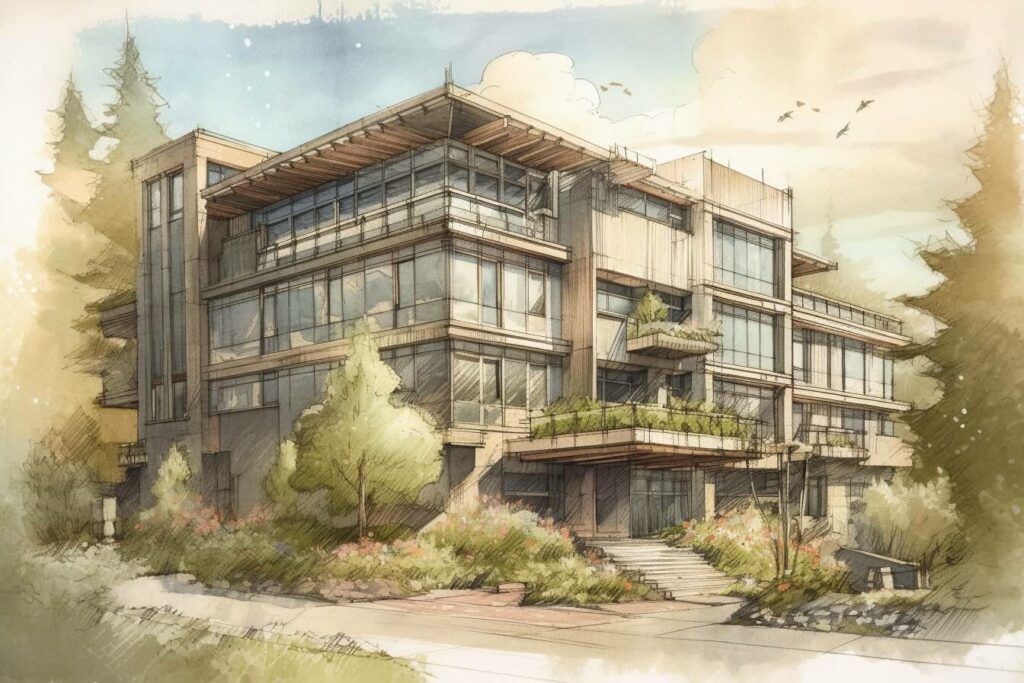Unlock Premium, Members-Only Content
Your source for the most relevant updates in sustainable construction
Are you looking to stay ahead of the curve in sustainable design? In 2023, it’s no longer just about meeting regulations and being eco-friendly—pushing the envelope and creating spaces that genuinely embrace sustainability.
Architects, interior designers, and construction companies are all searching for the latest and most popular trends in sustainable design for homes, offices, and public spaces.
This article delves into the top 10 sustainable architecture trends for 2023 that will help you stand out from the competition and put you ahead of the market. Discover how these innovations are revolutionizing the way we think about design and sustainability, and find answers to the most asked questions.
By the end of this article, you’ll be inspired to integrate these trends into your projects and eager to explore UGREEN sustainability consultancy services or UGREEN Skills, our sustainability educational platform for professionals and companies.
Sustainable Design Trend #1: Biophilic Design
Biophilic design has become a staple in sustainable architecture for 2023, promoting a strong connection between humans and nature within the built environment.
This design trend incorporates natural elements, such as plants, water features, and natural light, to create spaces that enhance well-being and productivity.
Integrating biophilic design into your projects will create healthier spaces and set you apart as a forward-thinking design professional.
Sustainable Design Trend #2: Circular Economy in Building Materials
The circular economy is making waves in the construction and design industries, and it’s here to stay. This trend emphasizes minimizing waste, repurposing materials, and designing for disassembly.
By incorporating circular economy principles into your projects, you’ll contribute to a more sustainable future and demonstrate your commitment to innovation in the industry.
Sustainable Design Trend #3: Energy Efficiency and Passive Design
Energy efficiency continues to be a top priority in sustainable design. Passive design strategies, such as optimizing building orientation, maximizing natural light, and utilizing natural ventilation, are crucial in reducing a building’s energy consumption. Mastering these techniques will provide clients with cost-effective, eco-friendly solutions to set your projects apart.
Sustainable Design Trend #4: Smart Technology Integration
Smart technology has become an essential aspect of sustainable design in 2023.
By integrating features such as automated lighting, heating, and cooling systems, you’ll create more energy-efficient buildings that cater to modern occupants’ evolving needs. Staying ahead in this technological realm will undoubtedly give you a competitive edge.
Sustainable Design Trend #5: Sustainable Urban Planning and Green Infrastructure
Green infrastructure and sustainable urban planning have become increasingly popular in 2023, offering numerous environmental, social, and economic benefits.
Incorporating green roofs, rain gardens, permeable pavements, and other green infrastructure elements into your projects will create more resilient and sustainable urban environments that will attract clients and showcase your commitment to sustainability.
Sustainable Design Trend #6: Adaptive Reuse and Upcycling
Adaptive reuse and upcycling are more than just buzzwords in 2023. These design trends prioritize repurposing existing buildings and materials, reducing waste and the demand for new resources.
By integrating adaptive reuse and upcycling strategies into your projects, you’ll contribute to a more sustainable construction industry and showcase your creativity and resourcefulness.
Sustainable Design Trend #7: Healthy Materials and Indoor Air Quality
In 2023, there’s a growing emphasis on selecting materials with a low environmental impact and promoting occupants’ health.
By opting for materials that emit fewer volatile organic compounds (VOCs) and prioritize indoor air quality, you’ll create spaces that foster well-being and appeal to clients who value health-conscious design.

Sustainable Design Trend #8: Zero Net Energy Buildings
Zero net energy (ZNE) buildings are the epitome of sustainable design. These structures generate as much energy as they consume through renewable sources, resulting in a net-zero energy balance.
By mastering the art of ZNE design, you’ll be at the forefront of sustainable innovation and attract clients seeking cutting-edge solutions.
Sustainable Design Trend #9: Modular and Prefabricated Construction
Modular and prefabricated construction methods are gaining traction for minimizing waste, reducing construction time, and improving overall sustainability.
By embracing these techniques and incorporating them into your projects, you’ll demonstrate your commitment to efficiency and environmental stewardship.
Sustainable Design Trend #10: Carbon Footprint Reduction and Life Cycle Assessments
As awareness of the built environment’s impact on climate change grows, there’s an increasing focus on reducing carbon footprints and conducting life cycle assessments.
By prioritizing low-carbon materials and sustainable construction methods, you’ll set yourself apart as a leader in the fight against climate change and appeal to clients who value environmentally responsible design.
Sustainable Design Trends: A Conclusion
Now more than ever, architects, interior designers, and construction companies must stay updated on the latest sustainable architecture trends to remain competitive and ahead of the market. By embracing these top 10 trends for 2023, you’ll contribute to a more sustainable future and distinguish yourself as a forward-thinking and innovative professional.
To further enhance your knowledge and skills in sustainable design, we invite you to explore UGREEN sustainability consultancy services or UGREEN Skills, our sustainability educational platform for professionals and companies.
By investing in your professional development and adopting these cutting-edge practices, you’ll be well-equipped to navigate the rapidly evolving world of sustainable design and secure your place as a leader in the industry.
Don’t wait – the future of design is sustainable, and it’s happening now. Join the movement and make a lasting impact on the built environment and the world around us.
Unlock Premium, Members-Only Content
Your source for the most relevant updates in sustainable construction
If you need our services in the Portuguese language, click here.